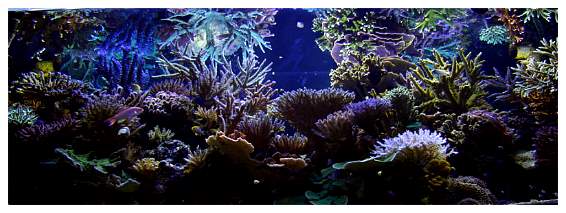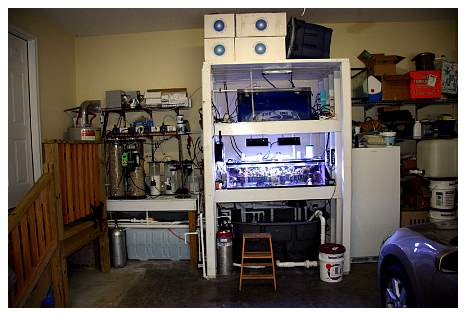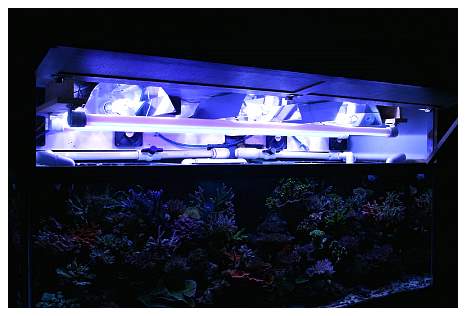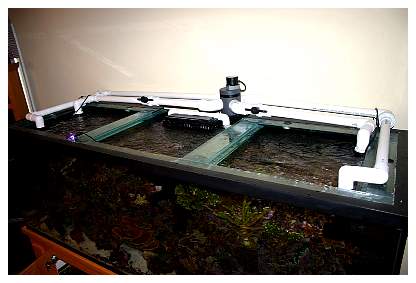|
Kip Peeler's (Kip) Reef Aquarium
Introduction:
After years of visiting
Reef Central and getting my monthly Tank of the Month "fix,"
receiving an e-mail telling me that one of my tanks was to
be honored seemed like a joke. I thought maybe Reefkeeping
Magazine was starting some "Honorable Mentions"
in its Tank of the Month feature. I was flattered to find
out that my stony reef would be featured just as some of the
previous
Tanks of the Month that I'd idolized.
This journey started for me while at UNC, when my girlfriend
bought me a freshwater betta in a small bowl to go on my desk.
That quickly turned into a 10-gallon freshwater tank that
offered me countless hours of procrastination from my studies.
During my first summer home after college in '96, I was visiting
a local fish shop and began to notice the more brightly colored
fish in what, I was soon to find out, was the saltwater section.
And so it began, my love for reef aquaria. The early days
were sketchy at best. Unfortunately, my only understanding
of how to operate a saltwater tank was learned through trial
and error. A few years later, the Internet boom allowed easy
access to information from fellow hobbyists, and successes
in the hobby ensued. I have run several saltwater tanks over
the last 10 years, and I read pretty much anything and everything
I can find about the hobby. The accumulated knowledge and
experience are what led to the stony tank featured herein.
 |
I wanted a larger reef tank to be the centerpiece of our
family room. The space available for the tank was measured
and a call went in to GlassCages
as quickly as possible, before my wife changed her mind. The
stand's and canopy's construction was arranged from a local
custom furniture builder. A few months later a large tank
appeared in our family room. The tank is basically a 180-gallon,
but built slightly taller and wider so the water volume comes
out to be around 225 gallons. Our house didn't afford the
space for a dedicated equipment room, so everything was initially
housed under the stand. That quickly changed as I plumbed
through the floor and expanded the system into the garage.
This is where I am fortunate to have a supporting wife who
puts up with my reef addiction.
Tank Specs in a Nutshell:
|
|
225-gallon
GlassCages eurobraced display with ~ 450 gallons
total system volume |
|
|
Three
250-watt single-ended XM10K bulbs on PFO m58 ballasts |
|
|
Four
140-watt actinic 03 VHO bulbs powered by two IceCap
430 ballasts |
|
|
Sequence
4300 return pump |
|
|
Sequence
5800 closed-loop pump connected to an OceansMotions
4-way wavemaker |
|
|
Euroreef
CS83 protein skimmer |
|
|
Custom-built
calcium reactor made by Brian Ferguson |
|
|
All
top-off through a Precision Marine kalkwasser reactor |
|
Tank Info:
The display overflows into a 40-gallon
sump under the stand. The return pump sends water back to
the display, as well as to a 30-gallon refugium that overflows
into the sump. The sump under the stand drains through the
floor, into the crawlspace, and out to a 150-gallon Rubbermaid
stock tank in the garage. An Iwaki pump in the garage returns
water from the stock tank back to the sump under the stand.
This expansion was originally set up simply to add more water
volume to the system, and to provide an easy place to do water
changes without carrying water into and out of the house.
I then got the idea of building a rack enclosure to place
a 70-gallon coral fragment tank and a 30-gallon quarantine
tank above the 150-gallon stock tank. A Sequence pump supplies
the coral fragment and quarantine tanks that drain into the
stock tank. Expanding the system into the garage was one of
the best things I could do. While the display is 225 gallons,
adding the sump and refugium under the stand, along with the
garage sump, coral fragment tank and quarantine tank (which
can be operated online or offline) brings the system's total
volume up to around 450 gallons. Having that much water supporting
a 225-gallon reef has led to rock solid water parameters and
has provided a cushion for any acts of idiocy on my behalf.
The only downfall to all of this is the look of, "Huh?"
when I explain the setup to the gracious soul who's volunteered
to baby-sit the tank when I go out of town.
 |
The current refugium has previously existed as an algal scrubber,
a coral fragment tank and "pod-ville," depending
on my needs at the time. Tons of copepods, amphipods, isopods
and mysids are running around in there with no knowledge that
they eventually will be sucked into the display to feed the
fish and corals. The refugium is lit by a 70-watt 10K double-ended
metal halide bulb adapted to a halogen fixture and driven
by a simple ballast that was custom-built into a small electrical
box. This light is fairly cheap and very effective for its
purpose.
Lighting:
Like many hobbyists, my quest for
the "perfect lighting" scheme almost never ends.
The tank was originally set up with 250-watt double-ended
20K bulbs on HQI ballasts. This combo seemed quite dim, so
I then changed to Phoenix 14K double-ended bulbs. I was happier,
but the lighting was still not what I wanted it to be. I then
decided to step up to 400 watts and used single-ended Radium
20K bulbs powered by PFO HQI ballasts (what some would say
are "overdriven"). Sanjay Joshi was coming to visit,
and I had to install stronger lighting to impress "the
lighting master." I have been very successful with this
lighting setup, but even as I write this, another lighting
change has recently taken place. I decided to try the 250-watt
XM10K bulbs. These bulbs, when powered by m58 ballasts, supply
nearly the same PAR as the Radiums I'd previously used, but
with less wattage and a more natural daylight look. I probably
should have left well enough alone, but I am always pushing
for bigger and better, so the main display's lighting was
supplemented by two 140-watt VHO actinic bulbs on IceCap 430
ballasts, and another set was added after I decided to run
10Ks. I have tried display photoperiods anywhere from six
to 11 hours and seem to get the best results from the halides
being on around 11 hours a day. The coral fragment tank is
lit by the old 250-watt double-ended setup from the main display
and is on a reverse-daylight photoperiod for eight hours.
Many thanks to Sanjay and his lighting
data/research that constantly makes me wonder about what
lighting I should use.
 |
Circulation:
Water flow is a hot topic lately,
especially with stony tanks. This has to be the most challenging
part of a maturing tank. When corals are small, water flow
is easy, but as they grow and begin to shield each other,
maintaining the necessary water flow can be quite complicated.
When I started this tank with just small coral fragments,
no corals were close to the plumbing outlets. Now, some are
directly in the closed-loop outlets' line of fire. Some corals
grow around the flow and some get their tips damaged
from the flow. It is very difficult to achieve high
flow in the middle of the tank with outlets and corals on
the ends. The corals close to the closed-loop outlets are
blasted, while corals in the middle of the tank need more
circulation. Given all of this I decided to use an OceansMotions
4-way setup with a version
2 drum that allows two ports to be open at once. I have
two outlets on each end of the tank served by the ports from
the OceansMotions unit. The device allows the flow from a
Sequence 5800 pump to sweep the tank left to right, mix, then
right to left, mix again and then repeat over the course of
a minute. This basically translates into a wall of water moving
across the tank in a continuous back and forth motion. It
is also like running two Sequence 5800 pumps in a closed-loop
configuration but with the price, heat and electrical usage
of only one. The mixing between cycles really provides some
chaotic current as well. I am very happy with my OceansMotions
setup and have variations of it installed on two other tanks
I operate. A Sequence 4300 return pump that feeds the display,
refugium, chiller and calcium reactor accomplishes additional
water flow. Nearly 1200gph of water flows from the Sequence
4300 through the display and sump. The return and closed-loop
pumps are located in the crawl space below the floor
for space preservation and noise dampening.
 |
Filtration:
The tank's primary filtration is achieved
from the water flow circulating in and around the 150lbs.
of Marshall Island live rock and over a shallow sand bed one
to two inches deep. I love Marshall Island rock for its shape
and porosity. It's pretty cool to look into the rockwork's
caves and see all of the sponges and tunicates growing. To
me, that is just another sign of a stable, mature system.
Additional filtration is provided by a modified Euroreef
CS83 protein skimmer located in the sump under the stand.
I ditched the stock foam filter for a gate valve modification
that allows me to fine tune skimmate production. The original
pump was upgraded from a Sedra 5000 to a Sedra 9000 to meet
the increasing demands on the system as the corals grow. I
also run a fluidized chamber with ROWA®phos media for
phosphate removal.
Supplementation:
The system's Ca-dKH demand is extremely
high since I packed so many stony corals into a relatively
small space. My current calcium reactor is a new beast that
was custom-built by Brian Ferguson and contains a lot of Schuran
media from FinsReef. It is a dual 8" x 30" reverse-flow
reactor built much stronger (¼" cell cast) than
any reactor I've ever used. I run all of my top-off water
through a Precision Marine kalkwasser reactor. The kalkwasser
reactor and calcium reactor do a pretty good job of providing
rock solid Ca-dKH readings for the system.
| |
Typical System Readings:
- Temperature:
78 - 80°F winter / 80 - 82°F summer
-
pH: 8.0 - 8.2 (various controllers)
-
Salinity: 35ppt (refractometer/Pinpoint meter)
- Ca:
400 - 420ppm (Salifert)
- dKH:
9 - 11 (Salifert)
- Mg:
~1300ppm (Salifert)
- NO3:
undetectable (Salifert)
- PO4:
undetectable (colorimeter)
|
|
Monitoring:
I think monitoring is where the geek
side of reefkeeping comes into play. If you are the type who
has to have a device that will take tank readings and send
you tank updates via text messages on your cell phone, you
might be a reef geek. All joking aside, the Aquacontroller
3 from Neptune Systems is a wonderful device to give you
a little peace of mind while you are away from home. Well,
either that or a heart attack when it sends you a message
saying there is a power failure and you are 500 miles away!
I've not yet employed it for controlling various parts of
the tank, but I love its monitoring/alerting capabilities.
Controlling the tank is done with several separate devices.
An Aqualogic dual-stage temperature controller runs the heaters
and the one-third horsepower Aqualogic chiller. Another single-stage
temperature controller will shut down the lighting if the
tank reaches 83°F (meaning the chiller has failed for
some reason). Two inline pH controllers monitor the tank's
and the reactor's pH to keep the system's pH from getting
too low and to keep the media in the reactor from melting
down. Another pH controller runs the float switch that controls
top-off water additions. This pH controller will shut down
the top-off system if the kalkwasser raises the system's pH
reading above acceptable levels. Yeah, I love backup/redundancy.
Feeding:
I feed frozen Mysis, a homemade
blend based on Eric Borneman's recipe, and various flake foods
on an alternating basis one to two times per day. The fish
are offered a nori sheet at least twice a week. Some would
think that I feed a lot, but I've found a high-import / high-export
system to yield much better results in coral color than just
a high-export system alone. I came to the conclusion around
Dec '05 that I was running my system too sterilely. I changed
that and have been happier since.
Maintenance:
I feel like I am always tweaking the
system in some way or another. Outside of projects such as
building a rack system for the coral fragment tank, moving
the chiller from the garage to the back patio or installing
a stronger closed-loop pump, regular maintenance of the tank
isn't too laborious. I typically run the algae magnet across
the glass once a week. The skimmer's cup and neck are cleaned
every two to three days. Water changes of roughly 90 gallons
are performed at least monthly and sometimes more often, depending
upon how the system looks. When performing water changes,
the sumps are also siphoned, the ROWA®phos is changed,
the kalk powder is replaced and salt creep is removed. Otherwise,
I perform the once or twice a year tasks such as replacing
bulbs, cleaning pumps, adjusting timers, replacing calcium
reactor media, etc.
Fish:
I currently have a pretty heavy fish
load, which is afforded by the extra water volume that was
added to the system. A few months ago I added a dozen damsels.
Damsels generally get a bad rap, but watching them swim in
and out of the coral branches is the most natural thing about
this tank.
- 1
Powder Blue tang
- 1
Desjardini Sailfin tang
- 1
Regal tang
- 1
Scribbled rabbitfish
- 2
False Percula clownfish
- 1
Purple firefish
- 1
Mandarin goby
|
- 1
Sixline wrasse
- 4
Scalefin Anthias (2 ♂
+ 2
♀)
- 2
Pink Anthias (♀)
- 2
Talbot damsels
- 3
Sapphire damsels
- 3
Marginate damsels
- 3
Pink Smith damsels
|
Corals:
The tank you see before you today
is the result of a stony addict setting up a new tank. It
contains way too many species to list. At one time I think
I counted around 80+ coral species in this tank. As mentioned
in the water flow section, now that the corals are maturing,
circulation is becoming more and more of a challenge. Real
estate is becoming an issue, too, as the need to fragment
corals is becoming more frequent. I have had corals grow into
each other on several occasions. So far, there have been no
casualties, but I have seen touching corals trade color pigments
between them. I would love to set up a much larger system
and move these corals into it without adding any more, thereby
allowing my reef to continue to grow, but on a much larger
and more spacious scale. I am sure this dream will come to
fruition someday, but not any time in the near future, as
my current home won't allow a larger display tank.
Some of my favorite corals in this tank include an Acropora
nana, an A. plana, a California blue A. tortuosa,
a pink Stylophora, a light green stag with purple tips,
an Acropora granulosa, a yellow tort (A. austera),
a large lime table Acropora with pink highlights, an
Acropora latistella, a nearly white bushy Acropora,
a Montipora undata, a blue stag of sorts and two "old
standbys:" the green A. yongei and A. micopthalma.
See… told ya I was an addict. I couldn't name just a
couple favorites. Some of my favorites include rare colorful
pieces, and others are just large mature corals that have
been with me a while. You know, the ones that have seen the
blood, sweat and tears.
Invertebrates:
The tank has a standard mixture of
Astraea, Cerith, Nassarius and Margarita
snails. Years ago I acquired some Strombus maculatus
from Indo-Pacific Sea Farms. These are great little snails;
their reproduction rates, combined with their small size,
make them great members of the clean-up crew. Additionally,
the tank is home to Tridacna crocea and T. maxima
clams, along with a beautiful royal blue and red Tuxedo urchin.
There is a trio of Scarlet cleaner shrimp, and a renegade
crab that I tried to kill countless times until I realized
it wasn't hurting a thing.
The Coral Fragment Tank:
A lot of folks who visit want to see
the coral fragment tank just as much as the display. I thoroughly
believe in spreading fragments among hobbyists because this
was how my tank was filled. As mentioned before, I have to
prune the corals in the display very frequently, so the coral
fragment tank is usually full. I also know quite a few hobbyists
who want to trade fragments, so my collection continuously
grows. There are several pieces in this tank that I would
love to have in the main display, but simply do not have the
room for them. I still hang onto them for that "next
tank down the road."
Final Thoughts:
I need to quit rambling and start
thanking some people. First, I would like to thank God for
placing the many creatures upon the Earth so that we may enjoy
them. I hope that we all become better stewards of our environment
so that generations after us will be able to marvel at the
natural world around them. I would like to thank my wife for
allowing my hobby to persist and even to become a part of
her life. She may not know all of the technical information
behind the setups, but her care and concern for the animals
is second to none. For those who nominated my tank to be honored,
and for those who received those nominations and further,
thought it was a good idea to feature this tank, my gratitude
abounds. I'd like to acknowledge my online buddy, Skilos,
who helped make a lot of this possible. Finally, if I may,
I'd like to dedicate this honor to my daughter, with whom
I look forward to many years of sharing this wonderful hobby.
For more information, visit www.KipsReef.com.
Feel free to comment
or ask questions about my tank in the Tank of the Month
thread
on Reef Central.
|
If you'd like
to nominate a tank for Tank of the Month, click here
or use the button to the right.
|
 |
|

